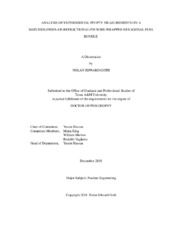| dc.contributor.advisor | Hassan, Yassin | |
| dc.creator | Goth, Nolan Edward | |
| dc.date.accessioned | 2019-01-23T21:43:01Z | |
| dc.date.available | 2020-12-01T07:32:36Z | |
| dc.date.created | 2018-12 | |
| dc.date.issued | 2018-12-05 | |
| dc.date.submitted | December 2018 | |
| dc.identifier.uri | https://hdl.handle.net/1969.1/174594 | |
| dc.description.abstract | In nuclear reactor thermal hydraulics modeling, detailed coolant velocity fields are essential
to accurately anticipating flow induced vibrations and temperature distributions in
the coolant and pins. Predictive computational tools are under development to produce these
coolant velocity fields using computational fluid dynamics. Turbulence modeling validation
is a necessary remaining step in the development of such tools. Prior liquid metal fast reactor
experimental velocity field data is not suitable for computational fluid dynamics turbulence
modeling validation. Therefore, a demand exists for experimental data to be collected using
non-intrusive probes with sufficiently high spatiotemporal resolution and of a hydraulically
similar fuel bundle.
The primary objective of this research was to produce high spatiotemporal experimental
velocity field data on a 61-pin wire-wrapped hexagonal fuel bundle such that commercial
sodium fast reactor core design and computational fluid dynamics turbulence modeling
validation may be performed. The primary phenomena of interest are the bulk swirl, local
swirl, subchannel mixing, and bypass flow. Flow statistics such as ensemble-averaged velocity,
root-mean-square fluctuating velocity, Reynolds stresses, Z-vorticity, and integral length
scales were presented.
The methodology to meet the primary objective was the utilization of a matched-indexof-
refraction experimental flow facility with laser-based optical measurement techniques. A
total of 9 different measurement locations at various bundle-averaged Reynolds numbers
have been investigated to generate a total of 50 unique datasets.
The scientific value of this work is twofold. It benefits the grand effort of turbulence
modeling validation by providing new high spatiotemporal resolution experimental data for
which benchmark activities may be performed. It also furthers the research and development
of liquid metal fast breeder reactor core thermal hydraulics to progress the U.S Department
of Energy’s advanced reactor development agenda. | en |
| dc.format.mimetype | application/pdf | |
| dc.language.iso | en | |
| dc.subject | liquid metal-cooled fast reactor | en |
| dc.subject | sodium-cooled fast reactor | en |
| dc.subject | lead-cooled fast reactor | en |
| dc.subject | experimental fluid dynamics | en |
| dc.subject | experimental thermal hydraulics | en |
| dc.subject | particle image velocimetry | en |
| dc.subject | stereoscopic particle image velocimetry | en |
| dc.subject | particle tracking velocimetry | en |
| dc.subject | matched-index-of-refraction | en |
| dc.title | Analysis of Experimental PIV/PTV Measurements on a Matched-Index-of-Refraction 61-Pin Wire-Wrapped Hexagonal Fuel Bundle | en |
| dc.type | Thesis | en |
| thesis.degree.department | Nuclear Engineering | en |
| thesis.degree.discipline | Nuclear Engineering | en |
| thesis.degree.grantor | Texas A & M University | en |
| thesis.degree.name | Doctor of Philosophy | en |
| thesis.degree.level | Doctoral | en |
| dc.contributor.committeeMember | King, Maria | |
| dc.contributor.committeeMember | Marlow, William | |
| dc.contributor.committeeMember | Vaghetto, Rodolfo | |
| dc.type.material | text | en |
| dc.date.updated | 2019-01-23T21:43:01Z | |
| local.embargo.terms | 2020-12-01 | |
| local.etdauthor.orcid | 0000-0003-1971-572X | |


